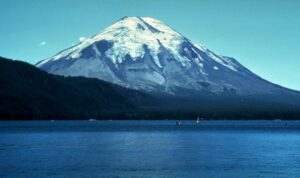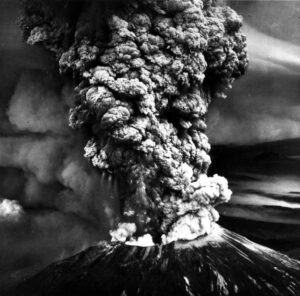Mount St. Helens, a perfect snow-white, cone-shaped mountain, was a favorite showpiece among Washingtonians for generations. A popular vacation spot, it boasted of beautiful lakes, challenging hiking trails, with rustic vacation homes and resorts nestled on the shores of pristine Spirit Lake. Photographers came from across the country to capture the elegant symmetrical cone of “America’s Fujiyama.”
Forty years ago today, on May 18, 1980, Mount St. Helens exploded in a violent eruption, following many earthquakes that spring. The blast blew off the top 1,300 feet of the mountain with five hundred times the force of the Hiroshima atomic blast. Within hours, the explosion destroyed 234 square miles of forest. Trees were either blasted away, snapped like pieces of straw, or scorched while standing, reducing one of the world’s most superb mountain landscapes to a gray wasteland.
Fifty-seven people lost their lives, though only about half those bodies were recovered. Most deaths were due to suffocation, others died from burns or as a result of falling objects. Of the lives lost, a few were scientists, but most fatalities were sightseers who had been repeatedly warned to stay clear of the area. An estimated 7,000 deer, elk and bear, and untold thousands of birds and small animals also perished. The Toutle River grew so hot witnesses reported seeing fish jump out of the water to escape the heat.
When Mount St. Helens first erupted, it sent a low-frequency shock wave straight up, which in turn reflected off several layers of the atmosphere and then bounced back to the ground in a large donut-shaped ring fifty to three hundred miles around the mountain. Thus, most people within fifty miles of the mountain did not hear the blast, yet it was heard as far away as Canada.
A menacing plume of ash boiled 60,000 feet into the atmosphere as the mountain turned itself inside out. The heavy ash cloud swept eastward across the continent in three days, and circled the globe in seventeen days. In Yakima, Washington, 138 miles from Mount St. Helens, emergency crews removed an estimated 600,000 tons of ash from the business district and residential areas. Ash flattened wheat fields and weighted down fruit trees. Agricultural losses in the Pacific Northwest totaled millions of dollars.
The blast and subsequent floods ruined or severely damaged more than three hundred homes, along with farm buildings and equipment. Hundreds of livestock were lost, either swept away in flood waters or buried in debris. Massive mudflows wiped out roads and bridges. For months afterward, extensive repair work was undertaken to regain use of the Columbia River and its tributaries.
Campers and loggers miles away from the blast zone heard an aftermath roar that one person described as sounding “like a couple of big passenger jetliners coming through the woods.” Within seconds, darkness covered the area and a terrific heat rolled in, burning people, animals and trees within its path.
My award-winning novel Tenderfoot is a work of fiction taking place during the months surrounding the Mount St. Helens eruption. Although the characters have been fictionalized, various experiences of blast victims represent true accounts.





I lived on top of the hill on Main Street in Pullman and owned the store named Stereo Plus at the corner towards town just before the Pullman Bank. My neighbor just below me was an engineer for the nearby dam and about 2:30 in the afternoon when we were plunged into darkness, national guard trucks were driving by loudly with their PA system saying to come and get your fall out kits. It was a height of the Cold War, and all the news was about Mount Saint Helens eruption, but no account for why we were in total darkness. We both thought a nuclear bomb and World War III had commenced, and the truth not being told, for those doomed. We sealed his house being newer, with duct tape, and shielded ourselves in his basement getting as many supplies together as possible – batteries, a radio, a TV as long as we thought it would last, and a couple bottles of good bourbon, and waited for the end. Yet, I can find nothing in my searches of similar experiences in thinking. Being nearly 150 miles away, we made no connection between being plunged into absolutely darkness had to do with mount Saint Helens. Anyone else here that lives in a town over 100 miles away north east of mount Saint Helens have similar experience?
Very interesting. We were actually in Africa with the Peace Corps when the mountain erupted and heard the news on BBC. When we came home, Mount St. Helens was one of our first visits. The devastation was hard to believe. However, it’s amazing how it’s grown back. Thanks for your comment.
We talked about the “anniversary” yesterday. We have a number of friends who were living in the Oregon/Washington State area and recounted the sad details of death, destruction, and what a horrendous mess it caused—one more learning experience in this challenging world we live in.
Yes, I think it was a wake-up call for many agencies. Thanks for your comment!
Thank you, Mary, for the detailed and accurate account of the eruption of Mount Saint Helens. We were in Skagit Valley and heard a blast. We went out to check, and our teenage daughter who was listening to her radio told us what had caused the blast. Now that we live in Pullman, the locals have stories of when the day turned pitch black, and the dust caused breathing problems. WSU closed that year just before the semester ended. So it was sort of a lockdown though for a much shorter period.
That’s interesting, Hema. We were in Africa with the Peace Corps and heard the news via BBC, so didn’t hear the details until we got home. I can imagine Pullman was hard-hit by ash. Thank you for your comment.
I lived on top of the hill on Main Street in Pullman and owned the store named Stereo Plus at the corner towards town just before the Pullman Bank. My neighbor just below me was an engineer for the nearby dam and about 2:30 in the afternoon when we were plunged into darkness, national guard trucks were driving by loudly with their PA system saying to come and get your fall out kits. It was a height of the Cold War, and all the news was about Mount Saint Helens eruption, but no account for why we were in total darkness. We both thought a nuclear bomb and World War III has commenced, and the truth is being with hell for those doomed. We shieldd up his house being newer, with duct tape, and shield ourselves in his basement getting as many supplies together as possible, batteries and a radio and a TV as long as we thought it would last, and a couple bottles of good bourbon, and waiting for the end. Yet, I can find nothing in my searches of similar experiences in thinking. Being nearly 150 miles away, we made no connection between being plunged into absolutely darkness had to do with mount Saint Helens. Since you were also in Pullman at the time, did anyone else think the possibility of a nuclear event nearby?
Thanks for your comment and observation. I have not heard that anyone thought the eruption might be a nuclear event.
Great account, Mary. As you probably know, I shared it to my FB timeline.
Thank you, Irene. I imagine you got some ash there in Oregon, too. And thank you for sharing it on your FB timeline.
I was living in England at the time this happened but I remember an American visitor showing us a vial of ash from the explosion–it was big news even over the Pond. I always thought, however, that making souvenirs out of something so devastating was really taking advantage of a horrific situation.
Andrea, thank you for your comment. We were in Africa with the Peace Corps when it happened. It was new news to us–since we were so far away we hadn’t heard about the rumblings beforehand. Since then, we have visited the mountain several times. The visitor center videos are spectacular.